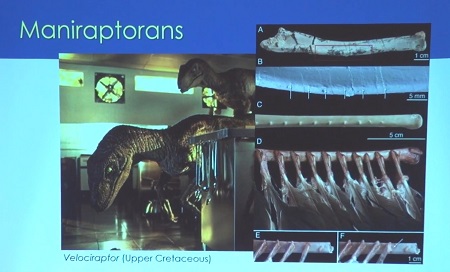Fujianvenator Prodigiosus - New Dino find puts Evolutionary Storytelling on Display |
|||||||||||||
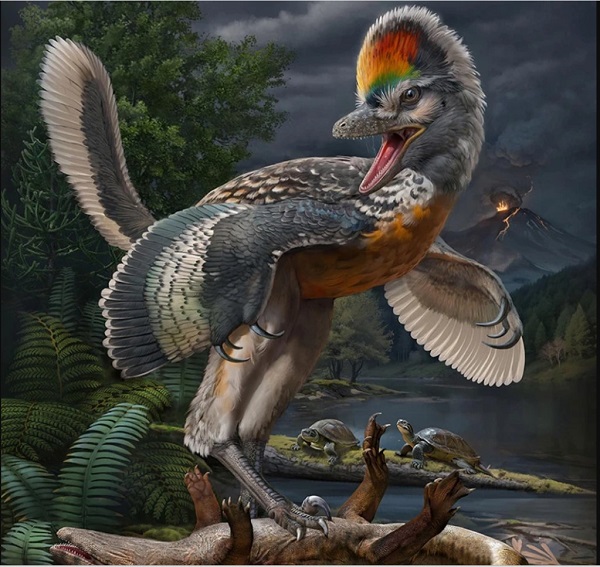 Fujianvenator Prodigiosus (artist impression) Credit: Chuang Zhao |
|||||||||||||
|
The prestigious science magazine Nature featured[1] a curious newly discovered dinosaur called Fujianvenator Prodigiosus which is causing a stir concerning their ludicrous theory that certain therapod dinosaurs evolved into birds. They're quite serious about that story though and the fact that they don't quite know where to place this dinosaur into that fictional setting is causing problems forcing a "rethink of bird evolution" as the title puts it. But it does make a good case study for our purposes to see how evolutionists weave their tales of fiction by misconstruing the evidence by building on their previous lines of fiction. Unfortunately for them such practices are like building a house with playing cards. And like a house of cards, there typically comes a card or piece of evidence that brings the whole house down. We've seen that with the Coelacanth, a fish thought to be older than the dinosaurs (lived 360 mya) and also thought to be evolving toward growing four limbs. The coelacanth has supposedly been extinct for 65 million years, but they have been found alive and well in the Indian ocean off the coast of Madagascar. And Tiktaalik, supposedly the ancestor of all four legged tetrapods, the supposed "missing link" between fish and four legged creatures. Later they discovered tracks from a four legged creature older than Tiktaalik, proving Tiktaalik cannot be its ancestor. In like manner, the typical evolutionary fictions are embedded in the description of this recent find Fujianvenator Prodigiosus. Let's take a look at how. Problems with the Evolutionary Story telling around Fujianvenator ProdigiosusLet' start with how it's depicted.
Following are various iterations of how Fujianvenator has been
depicted:
The differences are due primarily to fact that the fossil of Fujian that was found did not include the head, the feet were in poor condition and part of the tale was missing. Thus it is left up the artists' imagination as to how to depict those missing or unclear parts of the fossil evidence. So how are decisions made as to what those parts look like? There are two components, both of which are problematic. The first component, the
lesser evil of the two - is reliance on Cladograms. Paleontologist
look at features of the various creatures, and try to group them
according to common features, and then attempt to draw conclusions
on how closely one creature is related to another based on those
features. The cladogram[2] for Fujian looks like this:
No doubt based on perceived closeness to others in a "family" it might be given similar features even if there is no fossil evidence for it. The problem with this practice is the assumption that comes along with it. That assumption is the Darwinian assumption of "Common Descent". That all life on earth - all of it - from bacteria, to worms, to dinosaurs to humans, are descended from a single original ancestor which they call "LUCA" - the Last Universal Common Ancestor." They have never found or identified LUCA, but like the vain search for aliens from space, the search for LUCA continues. The belief in Common Descent and some unnamed LUCA leads Darwinists to believe that they should be able to connect all creatures together in a large "Tree of Life" somehow. That blinds Darwinist to another viable - and Biblical - option that their firm belief in evolution precludes: Common Design. Instead of originating from a common ancestor, all creatures originated from a Common Designer. And like all intelligent designers, solutions that have already been engineered for a particular need in one creature may be used in another creature. That is why you may see similarity in creatures across species, or what creationists would call Kinds. (Though to be clear, if talking taxonomy "kinds" equate to the family level, not the species level. I'm talking about general principles here.) Thus Creationist state that not all creatures are related; they're created according to their kind (Gen 1.21, 24) . And common features are due to a common designer, not a common ancestor. The other reason for the variances - what I consider to be the worse of the two, is the tendency to use the bad logic of an appeal to ignorance to depict creatures in a way that supports Darwinian evolution - even if there's no evidence for it, or even if the evidence points away from it. The classic example of that when depicting apes like Lucy (Australopithecus Afarensis) a creature that they want people to believe was evolving toward being human, is illustrating the creature with white scleara, which apes do not have, and other human features such as human expressions. In the case of Fujian here, since they did not find the head, the beautiful head feathers are all speculation. And whether or not it had the hooked claw like Deinonychus is also speculative since as the Nature article puts it "those digits were poorly preserved."
Feathers on Dinosaurs?We've been discussing feathers on dinosaurs - a topic that has been hotly debated for many years. Due to evidence presented by paleontogist Marcus Ross (a Bible believing Christian), I have come to the conclusion that some dinosaurs had feathers. That does not mean dinosaurs evolved into birds. Feathers are used for other things than flight like making displays as peacocks do and also for insulation. I will put the primary evidence that persuaded me in a sidebar at the bottom. For now let's continue with other errors in depictions by evolutionists: When did Fujianvenator Live?According to the Phys.org article on Fujian, "In-situ radioisotopic dating and stratigraphic surveys constrain the Zhenghe Fauna to the period from 150–148 Ma"[3] That means they used standard evolutionary reasoning and dating processes to determine the date they believe Fujian lived - which is 150 mya - the same period as Archaeopteryx, which is acknowledged by even most secularists as a bird - what they would consider the "first bird." So what are those processes used to date fossils? Radiometric dating and identifying the position in the geological column to date the fossil by the layer it was found in. Sounds very scientific, right? But
neither of those methods can accurately determine the age of a
fossil.
Radiometric dating does not give absolute dates, the best it
can give is relative dates. And those dates need to be calibrated
against something. What do they calibrate it against? The geologic
column. The American Journal of Science reported:
The dates given by radiometric methods must line up with what's expected from the date assigned to the geological column, otherwise it's rejected. How and when were the dates assigned to the geological column? In the early 1800's what we now call the geological column was created by a group of individuals who created a chart consisting of 12 primary divisions that represent geological layers. They gave the primary layers a name like "Jurassic" or "Cretaceous" and assigned "index" fossils that identify the layers, such that if you find those fossils, in theory you're in a particular layer. Finally they assigned dates to each layer going back millions of years. So according to the theory if you find a fossil in a particular layer, you can estimate the fossil was deposited within a certain time range given by the date assigned to the layer. The problem with dating fossils by the geological column, is that there was no original basis for assigning ages to the layers. And now that they've assigned ages, they're caught in the fallacy of circular reasoning. Because they use fossils to identify what period a particular layer of strata belongs to, and they use strata to identify the period a particular fossil belongs to. So strata date the fossils. And fossils date the strata. It's a circular loop with nothing but biased guesses as the original basis for the age of layers.
Sequence Errors in Evolutionary Dating and the Supposed Evolution of BirdsEvolutionists claim certain
therapod dinosaurs evolved into birds. To support that claim, they
offer the following sequence of supposed dinosaurs evolving into
birds:
150 Million Years ago (mya)
125-120 mya 124-122 mya
Do you see the problems here? - MicroRaptor - a gliding creature (it is supposed) which had flight capable feathers before such feathers supposedly evolved. - Sinornithosaurus and Sinosauropteryx - creatures from whom the complex flight are said to have feathers evolved, lived after the "first bird" Archaeopteryx already had such feathers, and contemporaneously with a gliding creature which similarly had such feathers. Another problem: they lived during the same time period, though based on feather complexity Sinosauropteryx should have existed first. So Fujian is not helping evolutionists in their supposed theories of the evolution of flight, nor with the supposed evolution of therapod dinosaurs into birds. The Nature story indicates evolutionists need to "rethink" their theory of bird evolution, but you can rest assured their faith commitment to the evolutionary story will not allow them to consider the obvious solution: Darwinian evolution never happened, and creatures were created according to their kind as the Bible states.
Duane Caldwell | September 30, 2023 Notes 1. "'Weird' dinosaur prompts
rethink of bird evolution", Nature.com, 6 September 2023,
https://www.nature.com/articles/d41586-023-02757-5,
unfortunately now behind a pay wall 3. "Chinese paleontologists find new fossil link
in bird evolution", Phys.org, September 6, 2023,
https://phys.org/news/2023-09-chinese-paleontologists-fossil-link-bird.html
4. O'Rourke, J.E.; "Pragmatism versus Materialism
in Stratigraphy", American Journal of Science, An International
Earth Science Journal, vol. 276: (January 1976); page 54; Referenced
by Russ Miller, Creation In the 21st Century, "A Pinch of Leaven",
aired March 13, 2016 5. Diagram featured on: 6. Marcus Ross, "Fuzzy with a Chance of Feathers",
presentation at Midwest Creation Fellowship, Jan 9, 2023,
https://youtu.be/xtYb5a9FnOY
|
Rational Faith

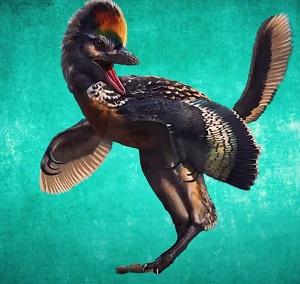

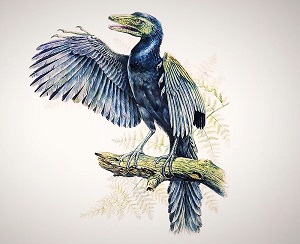
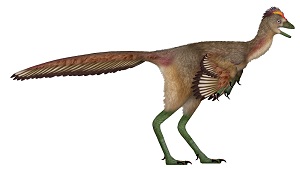

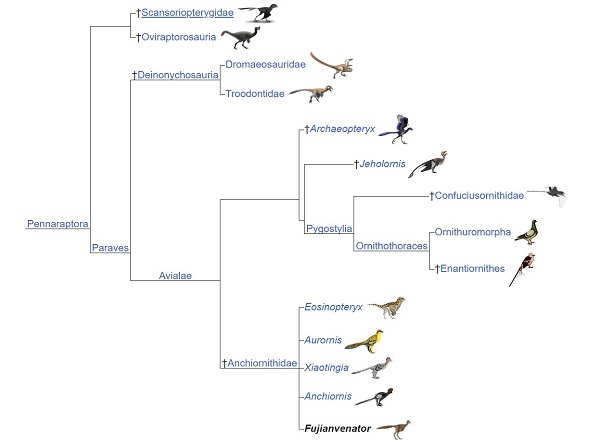
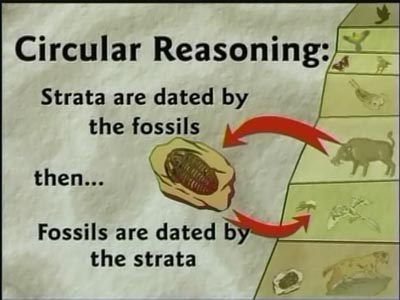
_DinosaurFeatherMystery_5722_500.jpg)
